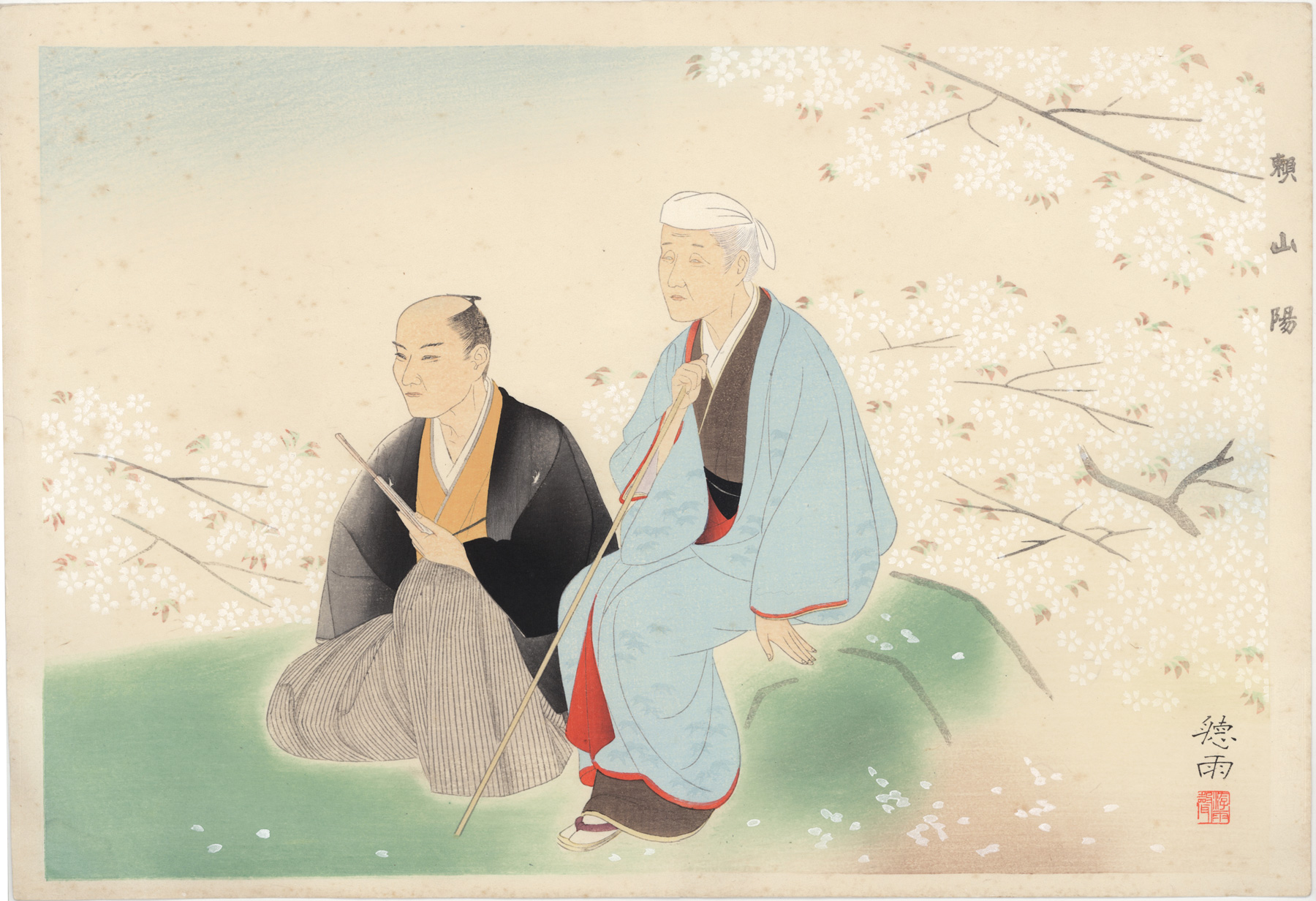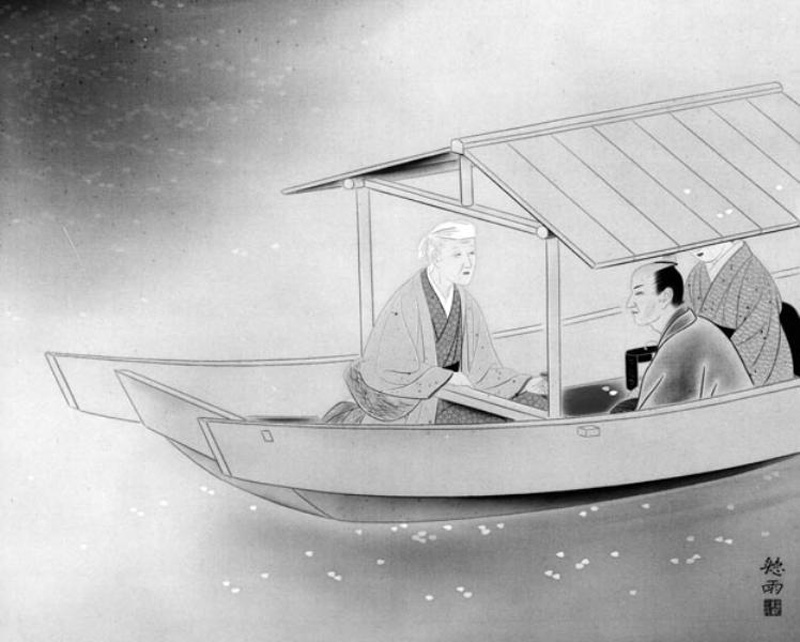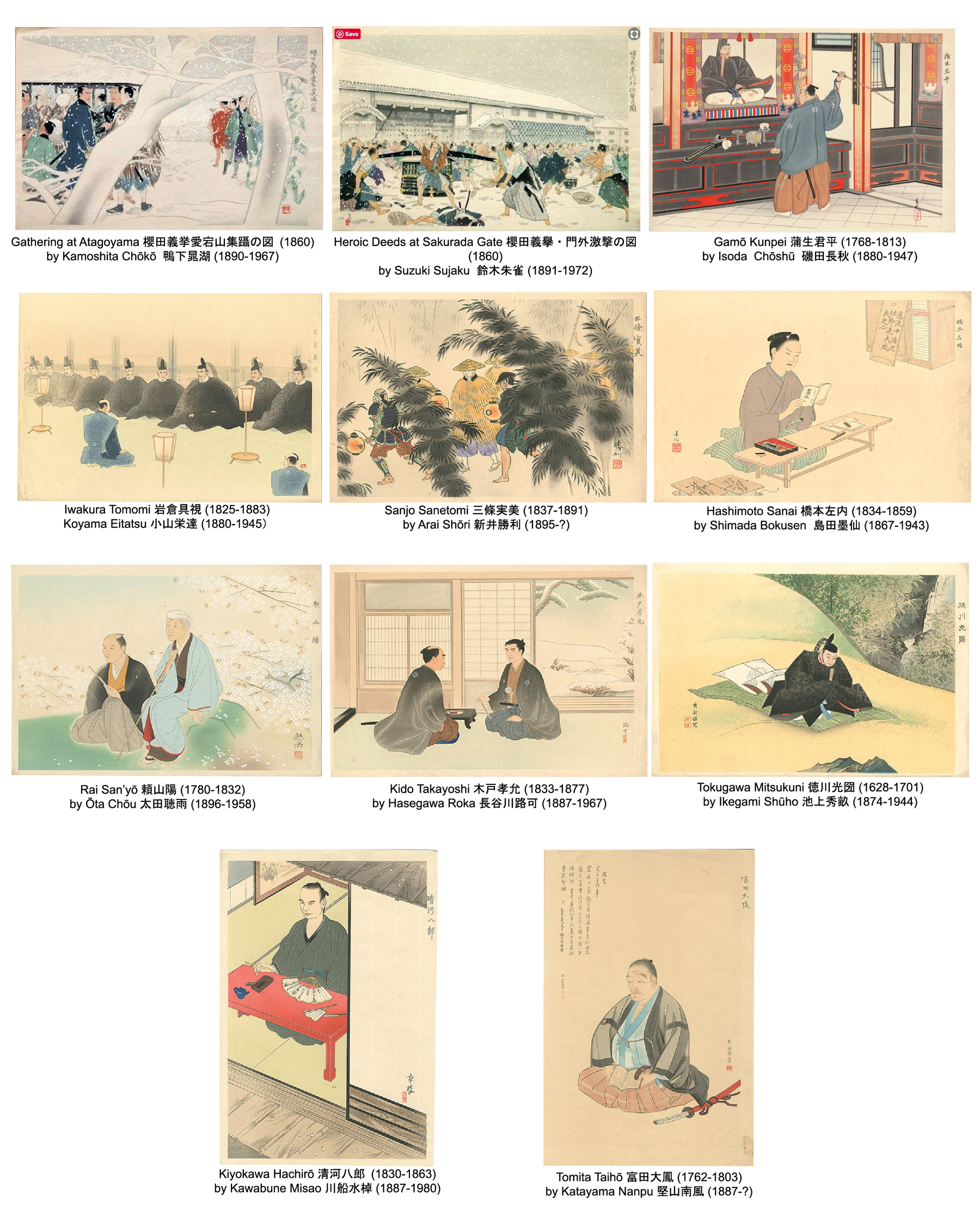About This Print
Ōta portrays the Confucian scholar, historian and calligrapher Rai San'yō (1781-1832) with his widowed mother Baishi viewing the cherry blossoms at Mount Yoshino in Yamato in 1827. This fulfilled her desire to once more see the cherry blossoms before her death. While there, he pointed out to his mother Emperor Go-Daigo's (1288-1339) tomb, lamenting the failed attempt of Go-Daigo to restore imperial rule.This print is part of a 1942 series of prints depicting historical figures who displayed great loyalty to the emperor and nation, with the purpose of reinforcing those traits in the body politic, as further explained below.
To see additional prints from this series in this collection go to Gamō Kunpei and Hashimoto Sanai.
In the same year this print was published, Ōta portrayed Rai and his mother in the below painting.
Rai San'yō and his Mother, 1942
color on silk, 56.7×72.3 cm
The National Museum of Modern Art, Tokyo J00194
About Rai San'yo
Rai is famous for writing his Unofficial History of Japan (Nihon gashi), completed in 1827, which tells the history of the Shogunate from the 12th century to the Tokugawa dynasty in the 17th century. He was a major influence on the sonnō jōi movement and the rise of emperor-centered nationalism at the end of the Tokugawa period.1
About The Series Thirty Great Loyalists of Early Modern Times 近世勤皇家三十傑
This series of thirty prints titled Thirty Great Loyalists of Early Modern Times depicts figures active in the mid/late Edo through Meiji eras who displayed great loyalty to the Emperor and, thereby, the nation. Issued in 1942 when the war in the Pacific was raging, the patriotic theme of these prints was clear.
 Watanabe "G" type seal embossed on margin of some prints (reproduced "G" type seal on left for clarity)
Watanabe "G" type seal embossed on margin of some prints (reproduced "G" type seal on left for clarity) embossed seal onmargin reading勤皇文化振興會Kinnō bunka shin kōkai [Society for the Promotion of Loyalist Culture]
embossed seal onmargin reading勤皇文化振興會Kinnō bunka shin kōkai [Society for the Promotion of Loyalist Culture]The series was conceived under the direction of the patriotic organization Kinnō bunka shinkōkai (Society for the Promotion of Loyalist Culture), about which little is known.2 For some of the prints in the series, the Society collaborated with the publishing business of Watanabe Shōzaburō, as Watanabe's "G" type seal is embossed in the margin, in addition to the embossed seal of the Society, both shown to the left. From the series' name we can assume that thirty prints were planned, although I could only locate eleven prints through a web search, which are pictured below.
All of the artists for the eleven prints were nihonga(Japanese-style) painters and their involvement might either indicate their patriotism or just a desire to stay in the good graces of the authorities during a time when artistic freedom was being greatly curtailed and artistic output directed to serve the war effort. While painting, particularly realistic looking Western painting in large formats, was the cutting edge of war art, prints served as the soft-propaganda media, focusing on building patriotism and support for the war effort on the home front. For a further explanation of the role of woodblock prints in the war effort see Prints During the War Years 1937-1945, the Occupation (and beyond).
  Watanabe "G" type seal embossed on margin of some prints (reproduced "G" type seal on left for clarity) |  embossed seal on margin reading 勤皇文化振興會 Kinnō bunka shin kōkai [Society for the Promotion of Loyalist Culture] | The series was conceived under the direction of the patriotic organization Kinnō bunka shinkōkai (Society for the Promotion of Loyalist Culture), about which little is known.2 For some of the prints in the series, the Society collaborated with the publishing business of Watanabe Shōzaburō, as Watanabe's "G" type seal is embossed in the margin, in addition to the embossed seal of the Society, both shown to the left. From the series' name we can assume that thirty prints were planned, although I could only locate eleven prints through a web search, which are pictured below. All of the artists for the eleven prints were nihonga(Japanese-style) painters and their involvement might either indicate their patriotism or just a desire to stay in the good graces of the authorities during a time when artistic freedom was being greatly curtailed and artistic output directed to serve the war effort. While painting, particularly realistic looking Western painting in large formats, was the cutting edge of war art, prints served as the soft-propaganda media, focusing on building patriotism and support for the war effort on the home front. For a further explanation of the role of woodblock prints in the war effort see Prints During the War Years 1937-1945, the Occupation (and beyond). |
The Eleven Extant Prints from the Series
1 sonnō jōi, the movement “to revere the emperor and repel the barbarians” which came to prominence after the 1858 signing of the Treaty of Amity and Commerce with the United States by the shogunate without the approval of the emperor. Followers of the movement murdered the Shogun's chief minister, Lord Ii Naosuke, in 1860 outside the Sakurada palace gate on a snowy morning, a subject of two other prints in this series. When the movement's goal of expelling all barbarians (i
2 The Society published a book in 1941 with the title 勤皇文化振興会 : 性質と事業 and the website of the Meiji Jingu Shrine in their chronology notes that in 1971 the received some works (possibly calligraphic works) collected by the Society. [source: https://www.rekishidb.meijijingu.or.jp/chronology/era_detail.php?year=1971&month=5]
Print Details
IHL Catalog #1969 Title Rai San'yō 頼山陽 Series Thirty Great Loyalists of Early Modern Times 近世勤皇家三十傑 Artist Ōta Chōu (1896-1958) Signature Seal unread seal (see above) Publication Date 1942 Edition Publisher Carver unknown (likely a carver employed by Watanabe Publishing) Printer unknown (likely a printer employed by Watanabe Publishing) Impression excellent Colors excellent Condition excellent Genre Miscellaneous Format oban H x W Paper 10 x 15 3/8 in. (25.4 x 39.1 cm) H x W Image 9 1/2 x 14 in. (24.1 x 35.6 cm) Collections This Print Honolulu Museum of Art 31638 Reference Literature
last update:
4/1/2019 created







